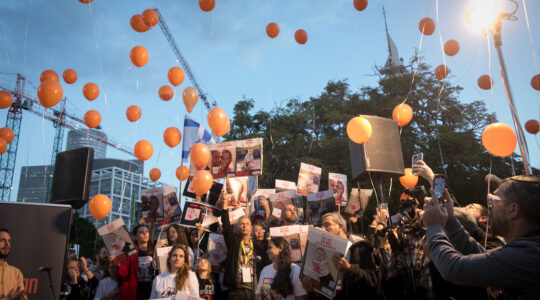When Argentinian special prosecutor Alberto Nisman was found dead Sunday, some observers described him as the 86th victim of Buenos Aires’ 1994 AMIA bombing.
In the days after the July 18 bombing leveled the seven-story building housing Argentina’s leading Jewish institutions, with the death toll still unknown and many people still missing, JTA reported that the local Jewish community “was left reeling.”
But the bombing, which was the worst terror attack on a diaspora Jewish institution since World War II and came two years after an attack on the Israeli Embassy in Argentina, still has people reeling. Almost 21 years later — due to bungled investigations, alleged government obstruction and cover-ups and diplomatic intrigue with Iran, which is widely believed to have been responsible for the attack — no one involved in the bombing has been brought to justice.
Now, the suspicious death of Nisman, who had been about to present evidence implicating Argentina’s president and others in a cover-up of the case, is yet one more development in a seemingly endless and labyrinthine series of events in the more than two-decades-long AMIA saga.
Over that period, JTA has posted regular updates of the progress or lack thereof in resolving the case. Questions began emerging about the government’s handling of the investigation as early as December 1994, when JTA noted that Argentine President Carlos Menem “has been criticized by the Jewish community in the past for not making more progress in the investigations of [the AMIA and Israeli Embassy] bombings.”
Seven months later, Argentina’s Jews marked the first of what would become many annual commemorations filled with lamentations not just for the victims but for the fruitless investigation.
But as the commemorations approach, Argentine Jews cannot hide a sense of despair and helplessness that after one year, the investigation has yielded only four arrests and no conclusive explanation of the bombing.
President Carlos Menem’s government has so far failed to get beyond accusing second-hand car dealer Carlos Alberto Telleldin of providing the van used as a car bomb, and arresting three others as alleged accomplices. And three of these occurred only recently.
Meanwhile, JTA noted, Ruben Beraja, president of DAIA, the umbrella Jewish political organization, “seems to be growing impatient,” having said at a press conference that if “time goes by without further developments, we will denounce the situation here and abroad.”
Among the numerous developments in the first decade of the troubled case: a trial of Argentine accomplices in which, before all were acquitted due to lack of evidence, the judge, Juan Jose Galeano was removed on charges of bribing a witness; and allegations that former Argentine President Carlos Menem accepted a $10 million bribe from Iran to cover up its involvement in the attack
In 2004, Alberto Nisman was appointed prosecutor and placed in charge of a new department overseeing the investigation. His appointment sparked hopes among local Jewish leaders that a new era had begun and the case might finally be resolved.
In an interview with JTA, Nisman showed “enthusiasm and high expectations” and criticized various missteps of his predecessor Juan Jose Galeano.
But even then, JTA was noting the threats to Nisman’s safety: “In recent weeks, protection has been doubled around Nisman after he received an anonymous threat against himself, his wife and his four-year-old daughter.”
Over the years, Nisman was outspoken and developed a reputation for being an indefatigable and hardworking prosecutor.
But, in a foreshadowing of his untimely death, the threat to Nisman’s safety was re-emphasized in February 2013, when JTA reported that he had just filed a criminal complaint “over a threat he received recently via email warning him to abandon his investigations of the bombings within 24 hours or risk the well-being of his daughters.”
JTA has documented Jewish history in real-time for over a century. Keep our journalism strong by joining us in supporting independent, award-winning reporting.





